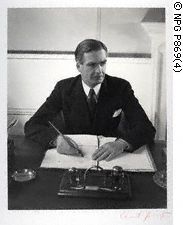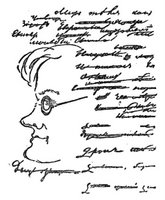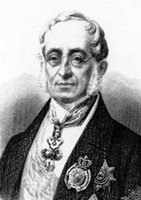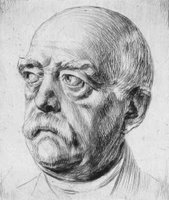
"I don’t think Kennan should be given
particular credit for showing that there was “a path between
appeasement and inevitable war.” The reason is that I don’t
think people like Secretary of State James Byrnes, the real
maker of American policy in the immediate post-World War II
period, ever believed that those were the only two possibilities.
He and other key U.S. policy makers had little trouble grasping
the point from the very start (and especially at Potsdam) that
a division of Europe in general, and of Germany in particular,
was a perfectly viable solution to the problem of how the two
sides could coexist without a war.
Was it the case, however, that only Kennan (in the X-article) could give
a convincing rationale for the containment policy? The X-article, to my
mind, was scarcely convincing on its own terms. It put forth an
internalist interpretation of Soviet foreign policy, which was very odd
for someone like Kennan whose whole approach to foreign policy was
supposed to be grounded in realist principles....
But maybe we pay too much attention to the X-article and containment when
we think about Kennan. Looking at his career as a whole, there’s a lot
about him I find appealing. I personally like Kennan’s 1950 book
_American Diplomacy_, especially the lecture about Wilson and World War I,
a lot more than Jervis does. It certainly made an enormous impression on
me when I first read it, and played a key role in shaping my own approach
to foreign policy. Jervis calls it “an inferior work of history,” but I
think it should not be viewed as a work of history at all, but rather as a
work that used history as a vehicle for presenting ideas about policy. I
also like the fact that Kennan was inclined -- although perhaps a little
too inclined, as Jervis suggests - -to lean against the prevailing wisdom....
One last point about Kennan, and that has to do with why the Kennan
myth-how he was the architect of containment and so on--is so persistent.
I think a lot of it has to do with the fact that when an interpretation
of the recent past first takes shape, people seize on what’s most visible.
The X-article got a lot of attention at the time; it was thus natural to
take it, along with other prominent events like the Truman Doctrine
speech, as one of the building blocks of a consensus interpretation when
people first felt the need for something of that sort. And once that
interpretation takes shape, it is often--far too frequently in my
view--more or less impervious to the arguments historians make based on
new evidence".
Marc Trachtenberg, "Response to Gaddis, RT."
H-Diplo. 8 May 2012, in
www.h-net.org/~diplo/roundtables/PDf/roundtable-VIII-24/.pdf.
"First, the matter of Kennan's impact on the origins of the Cold War. No one, I believe, who actually has had a chance to talk with those policy
makers who were "present at the creation" can deny the importance of
Kennan's 1946 "long telegram" from Moscow. From Harry Truman on down
American policy makers (as opposed to the foreign service diplomatic
intellectuals) were basically pragmatic deal-makers puzzled and angered by
a Soviet foreign policy that seemed inclined toward a belligerence and
expansionist thrust at fundamental variance with the agreements Russian
leaders were perceived to have given at Yalta and Potsdam. They had no
comprehension of either revolutionary ideology or the more
historically-based character of Russian expansionism.
The long telegram brought it altogether for them. It was widely read at
the top-level national security policy-making level by actors from Truman
on down, clearly had a big impact, and provided an intellectual framework
for what came to be called the policy of containment. The great irony of
course is that "containment" as implemented had a greater military
dimension that Kennan thought necessary. It may be argued as to just who
had the better judgment on this score. But Kennan's importance as a
catalyst seems undeniable to me".
Alonzo L. Hamby,"Measuring Kennan's Influence."
H-Diplo. 15 May 2012, in
www.h-net.org/~diplo
"In George Frost Kennan the Presbyterian elder wrestled with the Bismarkian geopolitician: that struggle produced the 'X' article".
Lloyd Gardner.
Architects of Illusion. (1970), p. 285.
The fine web site
H-Diplo recently had a very elongated and quite learned roundtable of professional diplomatic historians (among others Frank Costigliola, Walter Hixson, Wilson Miscamble) discussing the premier, second-half of the twentieth century diplomatic historian, John Lewis Gaddis's recent biography of perhaps the most influential professional diplomat in 20th century American history,
George Frost Kennan (to be reviewed subsequently in this journal).
Post-facto to the exchanges, was Professor Trachtenberg's piece. A piece which raises a fundamental point: exactly how influential and indeed important was George Kennan circa 1946-1948? This period in time, often being viewed as the
ne plus ultra of Kennan's influence in official Washington. Perhaps without intending so, Trachtenberg's piece in turn provoked other historians (Professor Hamby being one of the same) to respond to the question raised. From my own perspective, I do believe that George Kennan, in those two years, which we can mark as coming to a close with Dean Acheson's returning to the State Department in January 1949 , enjoyed an unusual degree of power and influence at the center of American diplomacy. Not that
per se, all of his ideas were very 'original' (as was correctly pointed out, Kennan's former Ambassador William Bullitt had already sent to President Roosevelt in 1943, a memorandum which in some way, anticipates much in Kennan's own thinking three years later). However, to ask for 'originality' from police-makers, particular in mid-20th century America (or elsewhere) is to make a quite erroneous assumption about how policy-makers actually go about 'making' policy. In writing his famous 'long-telegram' from the American Embassy in Moskva in February of 1946, Kennan's dispatch, which in some ways has all of the hallmarks of a
cri de coeur, Kennan provided quite unintentionally (as Professor Hamby aptly shows), the upper tier of the American government, with 'an idea', a 'concept' to explain the whys and the wherefores of Stalin's policies. This is not to gainsay the fact that,
sans Kennan's existence, that eventually American policy-makers would have come to conclusions which were similar in nature, if not as quite well expressed. Indeed, as the opening of the British Foreign Office documents proved, Kennan's opposite number in the British Embassy, the future
Sir Frank Roberts, at almost the same time, penned his own series of influential telegrams for London, which came to many of the same conclusions about Russian policy that Kennan did 1. Merely that if Kennan did not exist, then the road to containment, would have been a much less straightforward one, certainly it would have been a much less elegant one as well. The heart of the matter is that at that particular point in time, not in 1942 and certainly not in 1957, Kennan's thought processes, were matchable to those of his colleagues and superiors in government. Or as Hegel once put it:
"The great man of the age is the one who can put into words the will of his age, tell his age what its will is. 2"
Indeed, one can very well say much the same of
Eyre Crowe and his famous Foreign Office memorandum of the 1st of January 1907, as has been said of Kennan. That much of the thinking in the memorandum was hardly very original and that indeed there were not only logical inconsistencies but, factual
errata in the memorandum as it related to the recent past of Anglo-German interaction (as the then just retired Permanent Under-Secretary of State, Lord Sanderson pointed out subsequently) 3. What made Crowe's memorandum so influential in the Foreign Office was the fact that its conclusions seemed to dovetail with both the current thinking and the past experiences of the 'coming cohort' of rising stars in the Office: Sir Francis Bertie, Sir Charles Hardinage, Sir Arthur Nicolson,
et. al., all accepting as gospel truth the charge sheet against Berlin as formulated in Crowe's memorandum 4. To a lesser extent the same was true in London after Frank Robert's dispatches were read in the early Spring of 1946. To conclude it seems to me, by every empirical variable that in that short, window of time George Kennan was indeed as influential as a policy-maker as most historians have been averring for upwards of forty plus years now 5. In retrospect what seems remarkable is that Kennan's window of opportunity turned out to be so short. Unlike say either Crowe or Roberts or even exact American contemporaries like Paul Nitze. My own surmise on that mystery is that in many respects, Kennan too much of the conflicted romantic moralist as per Lloyd Gardner's canny description, to succeed at, much less enjoy the bureaucratic infighting and intrigue which a prolonged period at Foggy Bottom would have required. In that respect, Kennan's alienation from contemporary American society was too long-lasting and deep-rooted to afford him any patience to remain at the centre of power. His short stay at Foggy Bottom after returning from the Moskva Embassy was probably as much as he could endure. To unfortunately America's ultimate loss.
1. Sean Greenwood, "Frank Roberts and the 'Other Long Telegram': the view from the British Embassy in Moscow."
The Journal of Contemporary History. (January 1990), pp. 103-122. On the Bullitt memorandum, see: Robert Dallek.
Franklin D. Roosevelt and American Foreign Policy, 1932-1945. (1979), pp. 399-410 and passim.
2. G. W. F. Hegel.
The Philosophy of Right.
3. See: "Memorandum on the Present State of Britain's Relations with France and Germany." in
British Documents on the Origins of the War. Volume III. Edited G.P. Gooch & Harold Temperley. (1928), pp. 397-420. See, Ibid, pp. 428-431, for Sanderson's critique and Crowe's rejoinder.
4. As a noted scholar on this period of British Foreign Policy, noted the effect of Crowe's memorandum was huge inside the Foreign Office as it: "
expressed in a coherent and comprehensive form the ideas, which, instinctively held, had to an increasing extent governed the actions of the professional diplomats in the preceding years. Here for the first time the practical policies of the Foreign Office, substantially accepted by Grey as Foreign Secretary, were codified and synthesised into a system of remarkable power and intelligence." It would not be going too far to say that if one were to replace 'Grey' with Marshal & Truman' and 'Foreign Office' with 'State Department', that the reader would naturally assume that one was referring to Kennan and the long-telegram. For Crowe's memorandum effect inside the Foreign Office, see: George Monger.
The End of Isolation: British Foreign Policy, 1900-1907. (1963), pp. 313-316. A final point of comparison between the two situations is that unlike Kennan, Sir Eyre Crowe, remained for years after penning his memorandum virtually 'invisible' to even the educated lay, public. For an example of which, in his volumnious study in 1915 of Anglo-German relations before the Great War, Bernadotte Schmitt's index does not mention Crowe once. Indeed, the only Foreign Office official mentioned was the Sir Charles Hardinage, and that was merely in passing. See: Bernadotte Schmitt,
England and Germany, 1740-1914. (1916), pp. 183-184.
5. See in particular: Louis J. Halle.
The Cold War as History. (1967), pp. 105-109, and of course: John Lewis Gaddis.
The United States and the Origins of the Cold War, 1941-1947. (1972), pp. 303-305 and passim.












0 Comments:
Post a Comment
<< Home